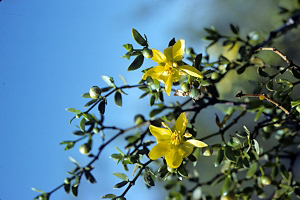The oldest living plant is a creosote bush in the Mojave Desert that is estimated to be between 9,400 and 11,000 years old! Also, the creosote bush is host to over 120 different bee species, with 22 of these species exclusively using this pollen as their food source.
Photo Credit: © R.A. Howard, Courtesy of Smithsonian Institution, Dept. of Systematic Biology, Botany.
Larrea tridentata
Common Name: creosote bush
Plant Functional Group: Evergreen broadleaf
Class > Order > Family: Magnoliopsida > Zygophyllales > Zygophyllaceae
What does the species look like?
Creosote bush is a multi-stemmed, evergreen shrub generally growing no more than 12 feet tall. Its small, yellow, somewhat showy flowers have both male and female parts and are pollinated by insects or are occasionally self-pollinated.
Creosote bush grows best in gravelly to sandy soils that are well-drained. It is highly drought-tolerant and can tolerate a wide range of temperatures (5 to 120 degrees Fahrenheit). Its typical habitats are valley plains, mesas, arroyos, alluvial fans, and gentle slopes of the southwest deserts.
Where is the species found?
States & Provinces
AZ, CA, NM, NV, TX, UT
Which phenophases should I observe?
Do you see...?
Leaves
Young leaves Larrea tridentata , young leaves are slightly more glossy than mature leaves.
How many young leaves are present?
Less than 3 3 to 10 11 to 100 101 to 1,000 1,001 to 10,000 More than 10,000
Flowers
Flowers or flower buds More...
How many flowers and flower buds are present? For species in which individual flowers are clustered in flower heads, spikes or catkins (inflorescences), simply estimate the number of flower heads, spikes or catkins and not the number of individual flowers.
Less than 3 3 to 10 11 to 100 101 to 1,000 1,001 to 10,000 More than 10,000
Open flowers More...
What percentage of all fresh flowers (buds plus unopened plus open) on the plant are open? For species in which individual flowers are clustered in flower heads, spikes or catkins (inflorescences), estimate the percentage of all individual flowers that are open.
Less than 5% 5-24% 25-49% 50-74% 75-94% 95% or more
Fruits
Fruits Larrea tridentata , the fruit is capsule-like and fuzzy with white hairs, and changes from green to dark brown and splits apart into five sections.More...
How many fruits are present?
Less than 3 3 to 10 11 to 100 101 to 1,000 1,001 to 10,000 More than 10,000
Ripe fruits Larrea tridentata , a fruit is considered ripe when it has turned dark brown and has split into five sections.More...
What percentage of all fruits (unripe plus ripe) on the plant are ripe?
Less than 5% 5-24% 25-49% 50-74% 75-94% 95% or more
Recent fruit or seed drop More...
How many mature fruits have dropped seeds or have completely dropped or been removed from the plant since your last visit?
Less than 3 3 to 10 11 to 100 101 to 1,000 1,001 to 10,000 More than 10,000
What do these phenophases look like?
The following Phenophase Photo Guides for this species have been vetted for accuracy by the USA-NPN National Coordinating Office. Most photo guides are developed for a particular local or regional monitoring effort, and some of the content may not apply to your effort or your region. However, we make them available to provide as much help as they may in illustrating phenophases for this species. If you have high quality phenophase photos that you are willing to share with us, please visit the Phenophase Photo Guidelines page.
Be aware there is variation from individual to individual within a species, especially across different regions, so your plant may not look exactly like the one pictured.
Since they do not always include complete definitions for the species, use these photo guides ONLY in conjunction with the official Nature's Notebook phenophase defintions included in the table above, in the phenophase definition sheet that downloads with the datasheet, or in the Observe screen in the mobile app.
